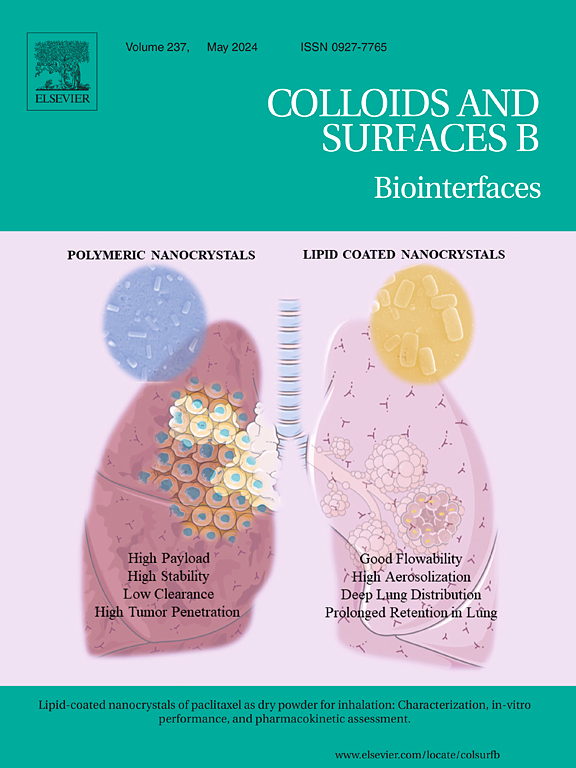Investigations into the topical hemostatic and wound healing efficacy of binary Hyaluronic acid/Collagen membranes coated with tranexamic acid and vitamin K; InVitro
IF 5.4
2区 医学
Q1 BIOPHYSICS
引用次数: 0
Abstract
A hemostatic dressing refers to a specific category of medical dressings that have been developed for managing and controlling bleeding. A synthesized hyaluronic acid/collagen (HA/COL) membrane integrated with tranexamic acid (TRAX) and/or vitamin K (Vit K) using the lyophilization technique is fabricated, followed by physical, chemical, and biological assessment. The clotting time and coagulation variables, as prothrombin (PT), partial thromboplastin time (PPT), and international normalized ratio (INR), were also assessed. The antimicrobial properties were tested against Gram-positive & Gram-negative bacteria, yeast, and fungi. The obtained membranes exhibited porous and swellable characteristics, demonstrating their ability to encapsulate vitamin K and/or tranexamic acid effectively. The cell studies demonstrated that the samples containing vitamin K exhibited less toxicity, in contrast to the TRAX compounds. The assessment of cytotoxicity is substantiated by conducting research on wound healing and determining the IC50 values. Additionally, the samples of vitamin K exhibited rapid clotting, which was corroborated by assessing the coagulation blood factors such as PT, PTT, and INR. The antibacterial activity seen in all samples can be attributed to the presence of HA among the membrane constituents. It is advisable to integrate vitamin K into the HA/COL membrane rather than within TRAX or a combination of TRAX.
止血敷料是指为管理和控制出血而开发的一类特殊医用敷料。使用冻干技术制造出一种含有氨甲环酸(TRAX)和/或维生素 K(Vit K)的合成透明质酸/胶原蛋白(HA/COL)膜,然后进行物理、化学和生物评估。还评估了凝血时间和凝血变量,如凝血酶原(PT)、部分凝血活酶时间(PPT)和国际正常化比值(INR)。对革兰氏阳性菌、革兰氏阴性菌、酵母菌和真菌的抗菌特性进行了测试。所获得的膜具有多孔性和可膨胀性的特点,表明它们能够有效地封装维生素 K 和/或氨甲环酸。细胞研究表明,与 TRAX 化合物相比,含有维生素 K 的样品毒性较低。通过对伤口愈合进行研究并确定 IC50 值,证实了对细胞毒性的评估。此外,维生素 K 样品还表现出快速凝血作用,这一点通过评估 PT、PTT 和 INR 等凝血因子得到了证实。所有样本的抗菌活性都可归因于膜成分中含有 HA。建议将维生素 K 添加到 HA/COL 膜中,而不是添加到 TRAX 或 TRAX 组合中。
本文章由计算机程序翻译,如有差异,请以英文原文为准。
求助全文
约1分钟内获得全文
求助全文
来源期刊

Colloids and Surfaces B: Biointerfaces
生物-材料科学:生物材料
CiteScore
11.10
自引率
3.40%
发文量
730
审稿时长
42 days
期刊介绍:
Colloids and Surfaces B: Biointerfaces is an international journal devoted to fundamental and applied research on colloid and interfacial phenomena in relation to systems of biological origin, having particular relevance to the medical, pharmaceutical, biotechnological, food and cosmetic fields.
Submissions that: (1) deal solely with biological phenomena and do not describe the physico-chemical or colloid-chemical background and/or mechanism of the phenomena, and (2) deal solely with colloid/interfacial phenomena and do not have appropriate biological content or relevance, are outside the scope of the journal and will not be considered for publication.
The journal publishes regular research papers, reviews, short communications and invited perspective articles, called BioInterface Perspectives. The BioInterface Perspective provide researchers the opportunity to review their own work, as well as provide insight into the work of others that inspired and influenced the author. Regular articles should have a maximum total length of 6,000 words. In addition, a (combined) maximum of 8 normal-sized figures and/or tables is allowed (so for instance 3 tables and 5 figures). For multiple-panel figures each set of two panels equates to one figure. Short communications should not exceed half of the above. It is required to give on the article cover page a short statistical summary of the article listing the total number of words and tables/figures.
 求助内容:
求助内容: 应助结果提醒方式:
应助结果提醒方式:


